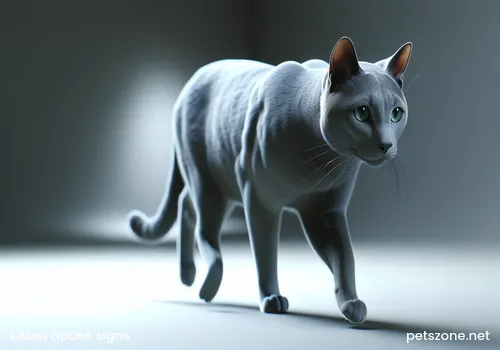Signs before a kitten is beaten to death_Abnormal表现 before a cat dies from abuse
When a kitten unfortunately suffers abuse and even faces life-threatening situations under extreme conditions, they often emit various silent "SOS signals." These abnormal manifestations may cover physical, behavioral, and psychological aspects, from hidden pain signs to obvious survival struggles. As responsible cat owners or animal lovers, it is crucial to understand and identify these signs, because early detection and intervention may save these fragile lives. Overall, cats before abuse-related death may show severe physical injuries (such as fractures, bruises, open wounds), extreme fear and hiding, drastic changes in behavior patterns (such as increased aggression or becoming extremely indifferent and numb), and obvious signs of health deterioration (such as rapid weight loss, incontinence).

Animal abuse is a heartbreaking act, especially when the victim is a helpless kitten. These innocent and fragile lives should grow up healthily under human care, yet they may suffer endless torment from some irresponsible or psychologically twisted individuals. Cats, unlike humans, cannot speak for themselves; they cannot directly tell us their experiences, but their bodies and behaviors quietly "speak." Therefore, we have the responsibility to learn to interpret these "silent languages," identifying signals that may indicate they are being abused or even at death’s door.
Recognizing these signs is not only to help those suffering kittens but also to raise public awareness of animal welfare and jointly build a more harmonious and loving society. Remember, every alert to abnormal situations may save an innocent life.
1. Physical "SOS Signals": Visible Pain
Abused cats often leave direct or indirect marks on their bodies, which are the most intuitive proof of their suffering.
-
1. Injuries and marks: Unexplained wounds
- Bruises, swelling, and fractures: If you find unexplained bruises, swelling on the cat's body, or it limps while walking, with abnormal limb deformities (such as joint swelling, bone dislocation), this is likely a sign of being struck or a fall. For example, a cat may have rib fractures caused by being kicked or leg fractures from being dropped from a height. Such injuries cannot be explained by normal accidents, especially if they repeatedly occur, warranting caution.
- Open wounds and cuts: Cuts, stab wounds, or burns on the skin with irregular edges, severe infection, or wounds in different stages of healing indicate repeated injuries from implements or burns. Some abusers may use knives, sticks, or open flames to harm the cats.
- Hair loss and skin abnormalities: Partial or large-scale hair loss may result from pulling or chemical burns. The skin may show redness, ulcers, scabs, or whip or binding marks. A cat that originally had shiny fur suddenly becomes rough, dirty, or develops bald patches may signal physical torture.
- Oral and dental injuries: Broken teeth, bleeding gums, mouth ulcers, or torn tongue or lips may result from force-feeding harmful substances or struggling when roughly handled. If the cat has difficulty eating or cries out in pain, the mouth should be carefully examined.
-
2. Malnutrition and deteriorating physical condition: Neglected life
- Rapid weight loss and emaciation: Long-term lack of food and water causes rapid weight loss, with ribs, spine, and hips clearly visible, seeming like only skin and bones. This is not just hunger but a severe sign of neglect and abuse. A healthy cat, even if not fat, should have appropriate muscle and fat coverage.
- Dull fur and lethargy: Malnutrition also leads to loss of fur gloss, becoming dry and brittle. The cat will have very poor spirit, constantly drowsy, slow to respond to stimuli, and even have a vacant gaze lacking vitality.
- Signs of dehydration: Poor skin elasticity (skin that does not promptly bounce back when pinched), sunken eye sockets, dry and sticky gums are serious dehydration signs, indicating the cat may have long been deprived of adequate water.
-
3. Abnormal excretion and hygiene problems: Neglected dignity
- Urinary or fecal incontinence or inappropriate elimination: Extreme fear, stress, or internal injuries may cause cats to lose control over urination or defecation, or being confined for long periods in small, dirty spaces forces them to relieve themselves in living areas. A cat that suddenly exhibits such behavior is not coincidental.
- Dirty body and foul odor: Cats living long in harsh environments without cleaning will have their bodies covered in waste or dirt, emitting unpleasant smells. This reflects long-term neglect and lack of care.
2. Abnormal Behaviors: Psychological Scars
Abuse not only leaves physical scars but also imprints indelible psychological trauma on a kitten’s young soul, expressed through its behavior.
-
1. Extreme fear and hiding: Signs of insecurity
- High vigilance or fear of humans: Normal cats are usually curious about humans, but abused cats show extreme fear, especially of certain people (like the abuser) or anyone resembling them. They may hiss, growl softly, or immediately flee and hide, showing great fear even towards friendly approaches. This fear may cause them to curl up in corners, under beds, or inside cabinets for long periods, unwilling to come out.
- Avoiding eye contact and touch: They avoid eye contact, curl their bodies, tuck their tails tightly. When approached or touched, they quickly escape or show strong resistance. This contrasts sharply with normal playful or affectionate cats.
- Startle reactions: Even light noises or sudden movements may scare them, causing body stiffening, dilated pupils, and even incontinence. This reflects their long-term state of high tension and unease.
-
2. Aggression or extreme submission: Two poles of stress response
- Increased aggression: Some abused cats become very aggressive, trying to protect themselves by attacking. They may scratch or bite without reason, even if normally gentle. This is a stress reaction for self-protection, not genuine "bad temper."
- Extreme submission and numbness: Other cats become extremely submissive, indifferent, and numb. They may stop responding to stimuli, not struggle even when beaten, with hollow eyes, appearing hopeless. This is learned helplessness, a result of prolonged mental torment, indicating they have given up resistance. This "acceptance" posture is even more heartbreaking than aggression, as it shows they have given up survival.
-
3. Stereotyped and repetitive behaviors: Psychological stress release
- Excessive licking or scratching: Overwhelming stress may cause cats to over-lick certain areas, leading to bald patches or ulcers. Or repeatedly scratch furniture, a behavior trying to alleviate anxiety.
- Continuous howling or abnormal silence: Cats may emit continuous, wailing cries, or conversely, become abnormally silent and barely vocalize. Both may be external signs of inner suffering.
3. Severe Health Deterioration: Life on the edge
Under continued abuse, the cat’s physical and mental health collapse, showing life-threatening signs.
-
1. Serious infections and complications:
- Wound infection with pus, systemic inflammation: Untreated wounds are easily infected, causing localized pus and even sepsis. Cats may show fever, lethargy, loss of appetite, and systemic infection symptoms.
- Signs of organ failure: Severe trauma, malnutrition, dehydration, and infection may eventually lead to organ failure. For example, reduced urine output may indicate kidney failure, and difficulty breathing may signal lung damage.
-
2. Extreme weakness and near-death state:
- Unable to stand or walk: Severely weak or seriously injured cats may be unable to stand or walk and can only lie limp on the ground.
- Weak breathing and slow heartbeat: Near-death cats breathe very weakly and shallowly, with slow and feeble heartbeats. Their body temperature may be abnormal with cold extremities.
- No reaction to external stimuli: At this stage, cats may show no response to touch or sound, with vacant eyes and dilated pupils.
4. What Can I Do?
If you notice any of the above signs and have reason to suspect a kitten is being abused, you must take action:
- 1. Stay calm, do not act rashly: If the abuser is present, do not confront them directly, as this may put you in danger and increase risk for the cat.
- 2. Collect evidence: Ensure your safety and try to photograph or video the cat’s condition, environment, and any abnormal behavior. Such evidence is important for later seeking help.
- 3. Seek professional help:
- Contact local animal protection groups: Such as the China Small Animal Protection Association or local stray animal rescue stations. They usually have experience dealing with such cases and can provide professional rescue and legal advice.
- Report to police: In urgent cases or suspected serious abuse, immediately call local emergency numbers (e.g., 110). Although animal protection laws are not yet perfect in mainland China, serious abuse may violate public order laws or other regulations.
- Seek veterinary help: For serious injuries, take the cat to a vet as soon as safe, even if the perpetrator is unknown, to protect the cat’s life and ease suffering.
- 4. Ongoing attention and advocacy: Focus on animal protection issues, participate in related activities, spread animal welfare knowledge around you, and jointly resist animal abuse.
Frequently Asked Questions
Q1: Does a cat injury always mean abuse?
A1: Not necessarily. Cat injuries can result from many causes like accidental falls, car accidents, fights with other animals. The key lies in the nature of the wounds, healing stages, presence of multiple wounds at different times, and whether the cat shows extreme fear, hiding, or odd behaviors. Repeated unexplained injuries or fear linked to certain people require high alert.
Q2: How to tell if a cat is thin due to hunger and not illness?
A2: Hunger-induced thinness usually comes with lethargy and dull fur, but after food is provided, the cat will gradually regain weight. If the cat remains thin despite sufficient food or shows other symptoms (vomiting, diarrhea, difficulty breathing), illness is more likely, needing prompt medical attention. Abuse-related hunger is often chronic and severe and may be accompanied by other abuse signs.
Q3: If a cat suddenly becomes very aggressive, is it a psychological problem?
A3: Sudden behavioral changes, especially increased aggression, can signal psychological or physical issues. It may stem from fear, pain, disease, or long-term stress and insecurity. After ruling out medical causes, consider environmental changes or interpersonal interactions (especially abuse) causing psychological trauma, leading to aggression.
Q4: What should I do if I find a neighbor abusing cats?
A4: First, ensure your and the cat’s safety. Do not confront the abuser directly. Collect evidence (photos, videos), then contact local animal protection groups, community committees, or directly notify the police. Inform relevant authorities and provide the evidence you have.
Q5: Are there laws against animal abuse in China?
A5: Mainland China currently lacks a dedicated "Animal Protection Law," but abusive acts may be handled under the "Public Security Administration Punishment Law" provisions related to disrupting public order or damaging property. Serious cases may breach criminal law. Some local regulations or animal management rules may also restrict abuse. Public supervision and advocacy are vital to promoting legislation.
Conclusion
The life of a kitten is precious, as they depend on human protection to survive. Identifying these silent "SOS signals" is key to offering these fragile lives a last ray of hope. Whether physical wounds or behavioral abnormalities, they may just be the tip of the iceberg of abuse. As a member of society, we have the responsibility to lend a helping hand—to see with our eyes and act with our deeds, so every life can bloom in love and respect. May all cats be gently treated by the world, far away from violence and fear.
References:
- World Animal Protection promotional materials on animal welfare.
- ASPCA’s guidelines for identifying animal abuse.
- China Small Animal Protection Association’s initiatives on stray animal rescue and welfare.
- Research from veterinarians and animal behaviorists published in professional journals and public science platforms on animal psychology and behavior.
-560x560.webp)

